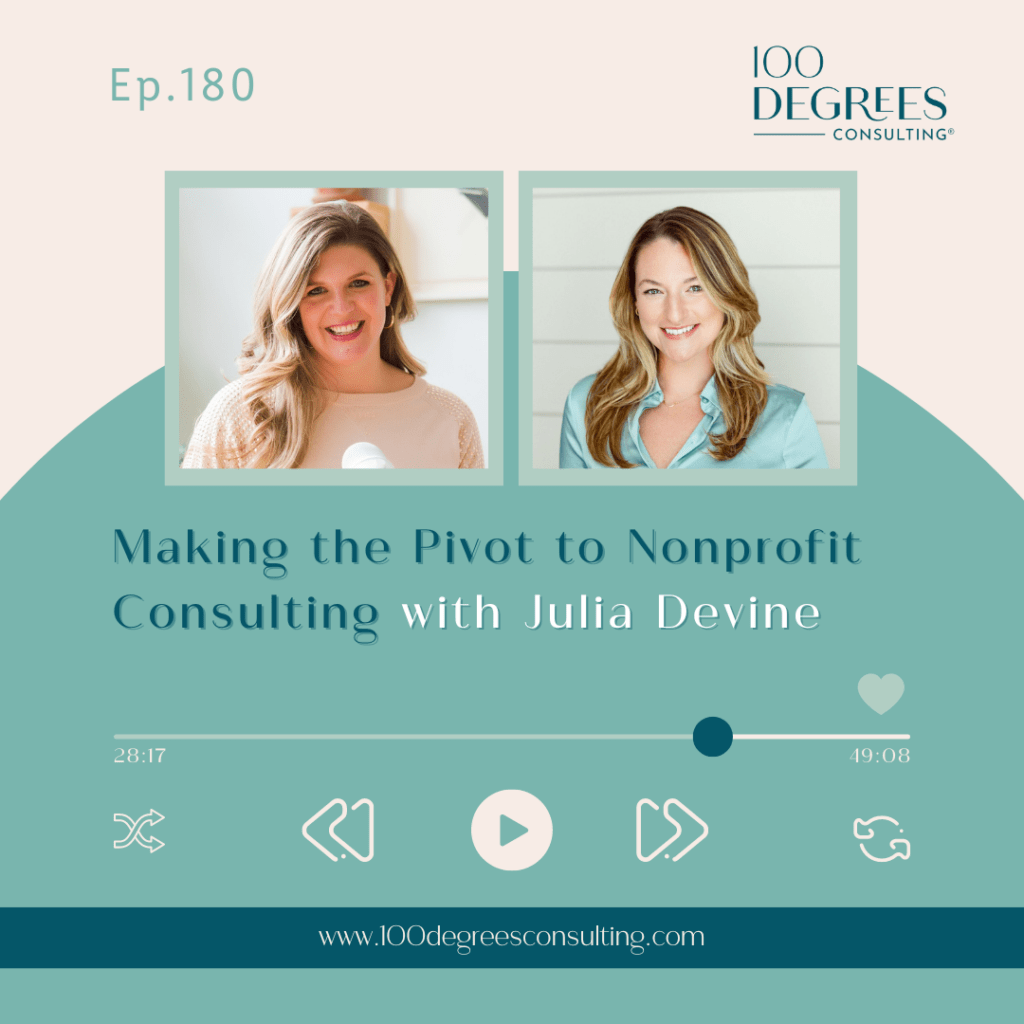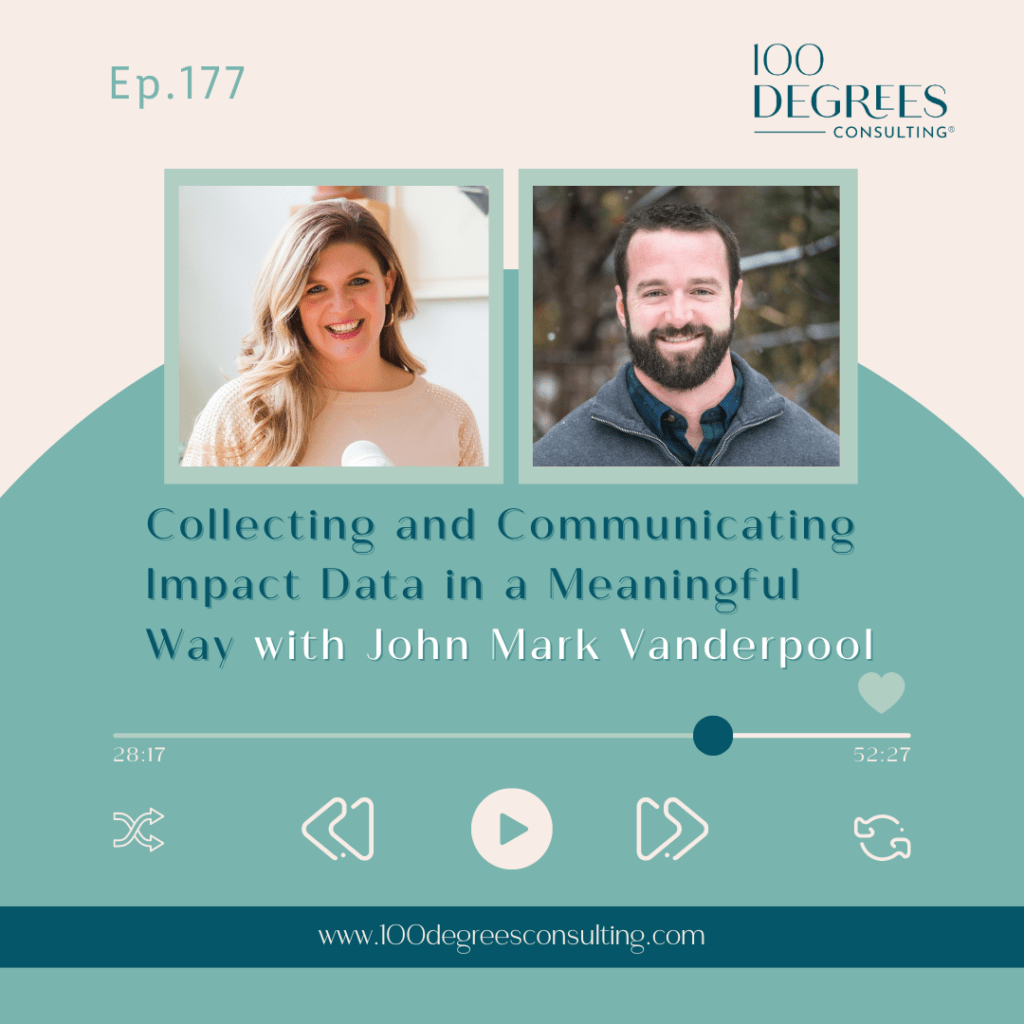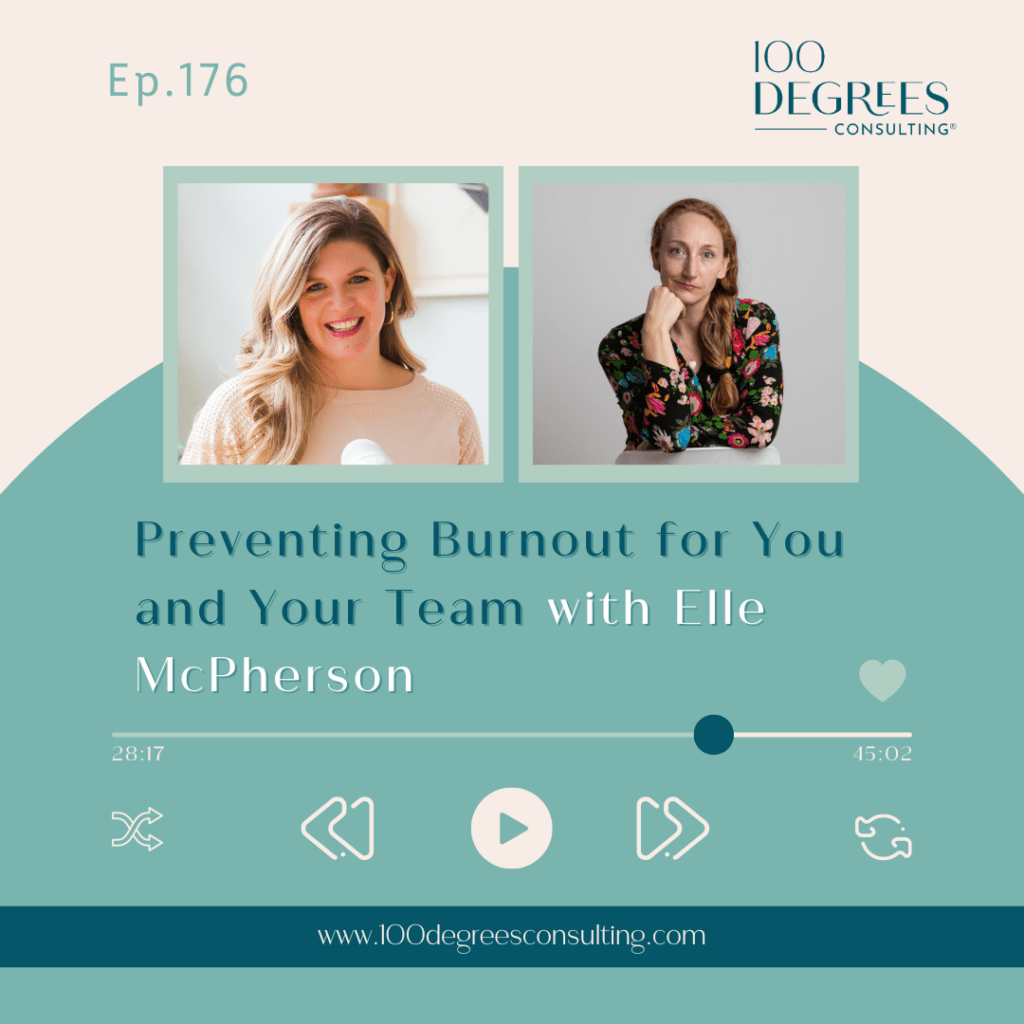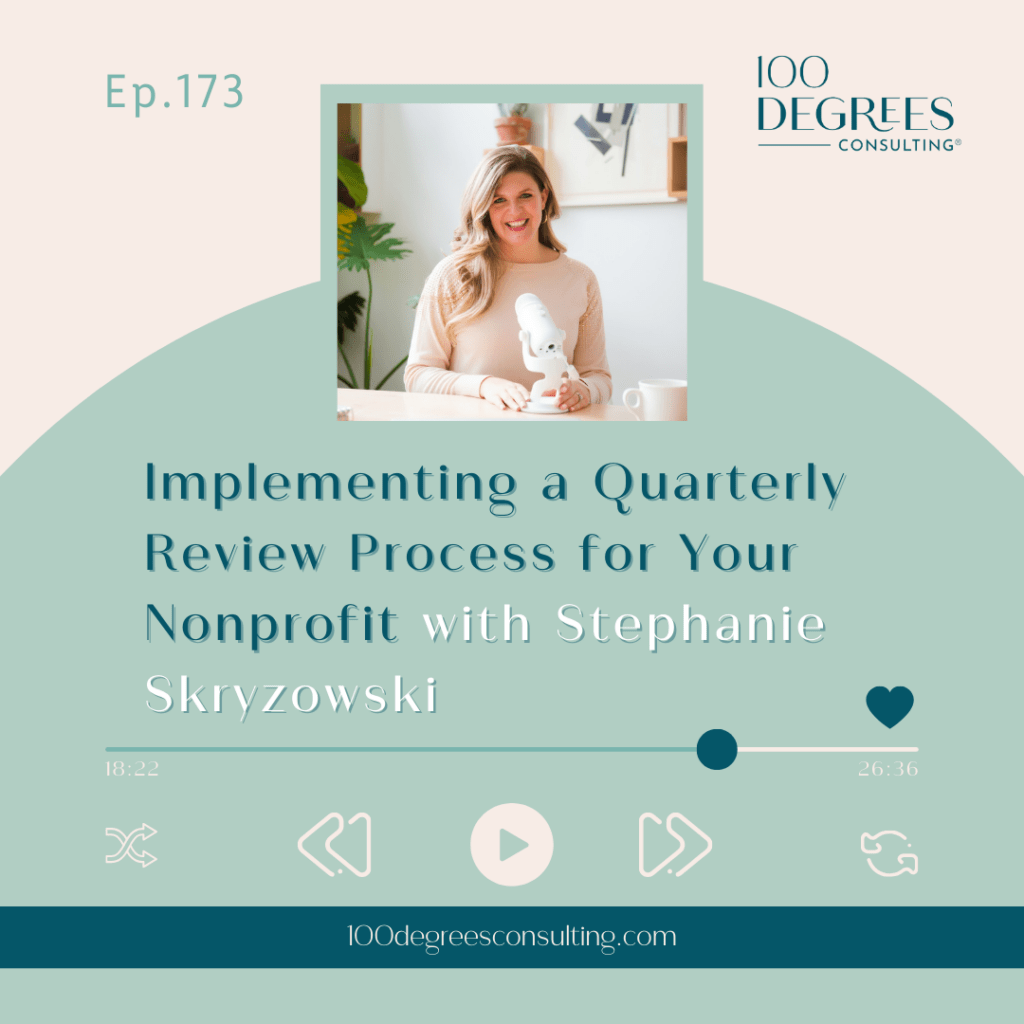Transcript Episode 166 – Elevating Your Individual Fundraising Strategy with Haley Cooper on The Prosperous Nonprofit
[00:00:00] Stephanie Skryzowski: Welcome to the Prosperous Nonprofit, the podcast for leaders who are building financially sustainable and impactful nonprofits and changing the world. I’m Stephanie Skrzewski, a chief financial officer and founder and CEO of 100 Degrees Consulting. My personal mission is to empower leaders to better understand their numbers, to grow their impact and their income.On this show, we talk to people who are leading the nonprofit sector in new ways. Innovative, disruptive, and entrepreneurial ways, creating organizations that fuel their lives, their hearts, and their communities. Let’s dive in.
Hello. Hello. Welcome back to the Prosperous Nonprofit Podcast. I’m Stephanie and I’m excited to have with me today on my podcast, Haley Cooper, who is The savvy fundraiser is that’s the name of her business, but [00:01:00] she also is a very savvy fundraiser. So she is a certified fundraising executive. So you will see those CFR E credentials after her name, which is awesome.
She’s also a certified stress management coach and a certified EMC train the trainer. She’s the founder of the savvy fundraiser, a nonprofit consulting and coaching business. She’s a founding board member and the past board member. Board Chair for the Orange County Nonprofit Professionals Network and a board member of OC Advisors in Philanthropy.
She’s also served on the boards of the Association of Fundraising Professionals, the OC Chapter and Impact Giving. So she has lots of board service, but also a lot of experience working in nonprofits. And I can’t wait for you to hear the story of how she got her start working in nonprofits and she jetted off to a place that you may not have heard of.
so much. I actually have been to this place many times, believe it or not, but you may never have heard of it before. So I’m excited for you to [00:02:00] hear her tell us the story of her journey in the nonprofit sector and then drop so many gems of wisdom all about fundraising. And I think she shared some really practical strategies about how to up your fundraising, your individual fundraising game.
And yeah, I think you’re going to really like this episode. So without further ado, let’s go talk to Haley.
Hey everybody, welcome back to the Prosperous Nonprofit. I am really excited to have here with me today, Haley Cooper. Haley, welcome. Thank you so much, Stephanie. I’m so excited to be here with you. Thank you. Yes. We just chatted a couple of weeks ago on your podcast. And now here we are chatting on mine all about fundraising.
So tell me and tell our listeners a little bit about, let’s see, let’s start with what you do now.
[00:02:55] Haley Cooper: Sure. So I am the CEO of the Savvy Fundraiser. And I was like, [00:03:00] I’m the CEO. It’s kind of fun. Um, I also am the host of the lead with heart podcast, which Stephanie recorded a few weeks ago and the savvy fundraiser really focuses on empowering emerging new organizations.So you’re like, what’s an emerging organization. It’s an organization that has been around for 10 plus years, has a budget over 500, 000 and has one to two people in their organization, but they’ve never done individual giving. Maybe they focus on events. They focused on grants, but they’re tired. They’re burnt out and they need a way to create more space for growth and innovation in the organization.
So I help them build out their fundraising strategies, a comprehensive fundraising strategy, tailored to their organization. And I go through a four part process to really dive deep into what that looks like. And it also includes. Collaboration and engagement among team members because as they’re starting out with their fundraising, it’s new and we have to empower the whole organization to [00:04:00] be involved and have a sense of ownership with that fundraising strategy.
[00:04:05] Stephanie Skryzowski: Hmm. Amazing. Yeah. I love that. Especially about the, the buy in piece and I’ve definitely been on the finance side of things and like, you know, fundraising is kind of doing their thing and we’re not talking to each other and that can be very bumpy. And I’ve also seen, you know, I’ve seen that work really well.So I love that. How did you get here? How did you, what has your journey looks like to get you to the point where you founded the Savvy Fundraiser?
[00:04:32] Haley Cooper: That’s a great question. Um, so I actually started in non profit straight out of college, although that wasn’t what I thought my trajectory was going to be. I graduated with a degree from St.Mary’s College of California with a degree in kinesiology. So I thought that I wanted to be a registered dietitian or exercise physiologist. And I was applying to school after school and got denial after denial. And I, right when I graduated college in 2011, went [00:05:00] on my first missions trip to Malawi, Africa.
And you’re like, why Malawi? Literally had to Google it on a map to figure out where Malawi was. And I was just blown away. And like coming from Orange County, out of my bubble into a country that I had never even heard of. It’s changed my life for the better. And I always say like, if you go on a missions trip, you get back after two weeks and you kind of get, you have a fire in you, but you get back into, um, you know, what your daily life was.
And about six months after that trip, the leader who had led that missions trip called me and he said, Haley, do you want to go make peanut butter in Malawi for a year? And I was like, sure, let’s go. He’s like, Haley, go home and pray on it. And I’m like, no, let’s do it. So we’re on a mission to end all malaria deaths, but because of malnutrition, children under five are still passing away.
So that’s where I co founded PB and J peanut butter and Jesus in 2012. [00:06:00] And I landed there by myself to a factory that was rebel, like literally nothing was there. We were promising factory, but there was nothing there. So. In the flat that I lived in, there was no water, very minimal electricity. I live with three wonderful German girls, but my role was to develop a peanut butter product and the establishment of a factory from inception to operation and through strategic planning and implementation, I positioned PB& J as a supplier for esteemed organizations such as UNICEF and other entities so that they could facilitate widespread distribution across the country.
And again, PB& J is peanut butter and Jesus. So it wasn’t just about feeding hungry bellies. It was about nourishing souls and sparking change. So yes, my journey, the heart of Africa started in the heart of Africa, but it’s really taken me places that even I couldn’t imagine. And I stepped away in 2016 and from 2016 to 2021, [00:07:00] I worked in both small and large nonprofit teams in the human services, homelessness, and youth sectors.
And like most people, cause we all know it’s the biggest joke. I have worn all the hats, I’ve done all the things, you know, back to the savvy fundraiser and what I’m doing now. I now have three kids under four, and so I decided to, while raising babies, decided to build and raise my own business. Um, and so I stepped away from in house work in 2022, um, to really Utilize what I’ve learned over the years, the leadership strategies, the fundraising strategies.
I’ve seen what works, what doesn’t work. And so from all of my experiences to offer non profits a way to have more balance and engage their teams and retain their staff so that they can really deliver on their mission.
[00:07:52] Stephanie Skryzowski: That’s amazing. I love how it’s like, Okay, we’re going to school for kinesiology. Just kidding.We are going to [00:08:00] Malawi and we’re going to start a nonprofit. Yeah, that’s amazing. And I would imagine like you’re saying, wearing all the hats was, I’m sure a bit of chaos, like while you were in it. And also was an opportunity to really hone in on. What you really liked, what you were really skilled at and what kind of came naturally to you.
So, which then led of course, to founding the savvy fundraiser and really focusing on the work that you do now, where you sort of conscious of that as you were working with those different organizations, or was it just like, I’m just wearing all the hats and just trying to keep my head above water.
[00:08:39] Haley Cooper: Yeah, that’s a good question.So yes, I definitely explored a lot of that. And even in my own business, like when I launched out in 2022, like I was doing all the things I was like writing email campaigns, grant writing, doing events. And luckily as an entrepreneur and an owner of my own business, like I get to say no, um, to things that [00:09:00] I really, Like want to focus on and I found that especially working with the nonprofits, my clients, that sometimes fundraising is just a band aid beyond an issue that’s actually there.
Like we write the grants, we ask someone for money, we ask people to attend an event. But then there’s nothing. And it’s like, we’re working so hard to plan that event, which I’m not anti events. I’m just more want to be more strategic about events, but it’s like, what’s the value? What are you trying to get out of it?
And is it worth the money or is it worth taking that time and investing in building individual donors and long term supporters and ambassadors for your organization? So I just found myself Overwhelmed with like all the tasks that I had to do. Nonprofits are overwhelmed and trying to say, Oh, that organization is hosting an event or there we, they got that grant.
Like, let’s go do [00:10:00] that because it sounds like a good idea, but then that creates conflict within the organization. People then get back to that overwhelm. And so that’s where I think, you know, I’ve really developed a solid fundraising strategy that it’s, it’s adaptable, right? Like we can add things to it, but.
It really helps people have a goal and allow people to see their important role in carrying out that goal from everyone in the organization, instead of just applying for like a 5, 000 grant that requires more money than the actual 5, 000, right? Like let’s be strategic on how we’re approaching these opportunities and really have that data driven decision and the ability to invite people into carrying out the goal with us.
[00:10:47] Stephanie Skryzowski: Mm hmm. Yeah. Oh my gosh. So much good stuff there. Talking about like shiny object syndrome, what you were talking about, like, Oh, we see this organization applying for that grant. We should do that too. Or we see this person over [00:11:00] here doing this event. We should do one of those too. It’s funny. I just recorded a solo podcast episode today all about like, what do nonprofits need to stop spending money on?And that was one thing I’m like, stop spending money on activities that other people are doing that you think are going to work for you. But like, They’re actually not like, that’s probably not the best use of your resources. And so I think that’s huge. And you mentioned being able to say no as an entrepreneur, as a business owner.
And I think that nonprofits maybe need to get a little bit better at saying no as well. Like not all money makes sense for your organization. Thinking about the 5, 000 grants that. It costs way more than 5, 000 to apply for and then manage and report on, et cetera. So I think all of that is, is so good. And so let’s talk a little bit more about buy in and you know, how to kind of get people on board so that as an organization, we’re all in agreement or at least if not agreement, like at least alignment when we’re saying no to [00:12:00] things or we’re not just chasing that next shiny object, because we’re all on the same page about like, What is our strategy?
What direction are we going? So what have you seen work really well for organizations to get buy in on fundraising strategy?
[00:12:16] Haley Cooper: Yeah, that’s a really good question. And, you know, I think I utilize this framework called EMC leadership framework. I would train the trainer. It was founded by Dr. Lila Gershfeld, who I found in mid season.And when I was in an organization with that shiny object syndrome and felt like the weight of the world on my shoulders. And so I think to your question, like there’s a few areas of getting buying and belonging that I’ve seen nonprofits either do really well or struggle with. One of them is internal clarity.
So Getting donor trust and confidence starts with internal clarity. And so everyone has to have a clear understanding of what the mission, the vision, and the values of [00:13:00] the mission is. And if you can’t get that clear on the inside, people don’t have that buy in and belonging and understanding of that vision and where you want to go.
It’s really difficult, especially as a fundraiser to effectively convey this to donors. I remember walking into an organization and they were doing like five different things. And I share the story all the time, but I was confused and like, I would go talk with donors and they would be like, Haley, like, what do you actually do?
Like, are you serving in Venezuela? Are you serving native Americans? Are you serving local kids? Like. We’re confused and I’m like, clearly I’m confused too. So that internal clarity and like sitting down our C suite as a director of development at the time, but I sat down the C suite and I was like, we have to get really clear on this messaging and how each person in our organization fits into that vision.
Because then that way I can go out and talk to donors and [00:14:00] allow them to see themselves in that vision. But it starts with that internal clarity and getting that, those people within the organization, the staff, the volunteers, the board members, to understand, again, like, how they can advocate on behalf of the mission.
So I’ll stop there. I probably have more to say about that, but I really think it starts with that internal clarity.
[00:14:23] Stephanie Skryzowski: Yeah, yeah, no, I think that’s huge. And I, I’ve been talking to a client lately, who’s kind of exploring this process on like, well, what does our growth look like? Are we just going to do more of the same, like indefinitely?And it, because they’re kind of in the same position where it’s like, well, what are we communicating to donors? And. Some people are communicating one thing as to what our goals are and other people are communicating something else. And so really making sure that everybody is on the same page. It’s like, what do we do?
What is our vision? What’s the direction that we’re going? Because I think that over time that sort of like [00:15:00] disintegrates a little bit, and it’s not really, you know, it just, it happens with time. So I think that that. Is huge. I think that’s, um, yeah, I think that’s such a good point. If you want to say more, go for it.
[00:15:12] Haley Cooper: Yeah. So, I mean, what you just said, like, is so important and it’s so normal. And, you know, based on the EMC leadership process, which is based in attachment science. And I always like talk about neuroscience before we get to like the practical strategies, but it says like why the importance of buying and belonging is because it’s like our basic needs, above housing, food, and shelter, and water.Like, We need buying and belonging and attachment says when we work together. We build a bond and emotions are the bond that hold that together. So specifically with like your organization that you were talking about, or the one that I was talking about, when people don’t see how they’re a part of that vision, they become emotionally disconnected.
And then conflict starts happening because they don’t have that sense [00:16:00] of buying and belonging. And conflict is never about content. It’s about emotional disconnection. It’s about how do I play an important role in your vision or in your life? Like, I want to know that I matter to you and the work that we’re doing is important.
And so it’s really important for organizations and like within the EMC leadership framework, we go through a reconnection forum to help people really see how, like, when we lose each other, we’re talking in the same circles, we’re talking about the same thing, but we like, lose the aspect of who we are.
You care for me. And so it’s really important to get that back and have this conversation of, Oh, you see me, we share the same fears. We share the same reality. We just lost each other along the way. And we say like, it’s always a negative cycle. There’s no blame person. It’s just like how our brain is wired to react.
But when you get that sense of buying and belonging, people are more likely to collaborate [00:17:00] and like, they’re more likely to communicate and take risks and innovate and grow and see how working together gets them towards that common goal, that common vision. And again, then it comes back to, you feel more confident inviting people into your mission.
You feel more confident knowing that How your role plays in fundraising, especially on like the board level, staff level, like you’re more willing to be an ambassador on behalf of the organization because you feel that connectedness. You know how important you are to each other. You get buy in in that vision and you’re like, Hey, Let’s go preach it from the mountaintops, right?
Like let’s invite people in. This is an exciting opportunity for people to realize their generosity. And our organization is a tool in which we can do that.
[00:17:46] Stephanie Skryzowski: Hmm. That’s so interesting. And I love the connection to neuroscience. That’s so cool.Hey, there are amazing listeners. I hope you’re enjoying another fantastic episode of [00:18:00] the prosperous nonprofit. Before we dive back in, I have a quick favor to ask. That’s right. If you are getting value, knowledge, encouragement, or even just good vibes from our show, please share the Prosperous Nonprofit with a friend or colleague who you think would love it as much as you do.
It’s like passing along a good book or recommending your favorite local coffee spot. Please take a quick second to hit that share button, send a link, or even give a shout out on social media. Your support means the world to me. Thank you for being awesome. Thank you for being here. And now back to the show,
I would imagine that I think we know this. Most nonprofit leaders are like super busy and we’re just flying through every single day. Just get everything that needs to get done. And I would imagine that It takes a little bit of slowing down to get this buy in and to help give people a sense of belonging.
And so [00:19:00] what would you say to that person? That’s like, I do not have time to slow down and get people’s bar to get people’s buy in and to make them feel like they belong. I mean, I love what you said. Like, The results that are going to come from that. I think that’s, I think that’s huge. But yeah, what, what would you say to, um, yeah, to those organizations or those leaders that are like, this sounds like a lot of work and a lot of time.
[00:19:25] Haley Cooper: That’s a good question. Um, I would say It’s a strategic comparative, like it’s not just a feel good idea of like making space for people to voice their opinions, voice their needs, voice their fears. You have to, because our shared friend Tucker Wanamaker was on my podcast and we were talking about this idea of like if you do strategy first.You’re not going to get the buy in belonging. You’re not going to get people who, they might execute it, but they won’t execute it well. Like you have to start with buying and belonging. It’s a strategic [00:20:00] imperative. And I was just recording a solo episode on my own podcast and for a challenge that I’m doing.
And it was like embracing solitude. Like you have, like, I get it. Like there’s fear in the nonprofit that if you don’t keep going, it’s also how we’re wired in times of stress. Like we want to be busy. We want to add more. But you have to create space in your schedule, whether it’s for you to embrace solitude, and it’s just to take a breath.
It doesn’t even have to be a full hour in your schedule a week, like maybe 5, 10, 30 minutes, maybe go for a walk. But it allows you to get that clarity. It allows you to refocus. And kind of get your head out of the work that you’re doing because we all get stuck in it, right? And we have to solve that problem that’s ahead of us.
We have to do this, but there isn’t anything we have to do. What we should do is embrace that solitude, embrace that space, make that space for safe conversations, because [00:21:00] it’s a strategic imperative. I feel like it’s a non negotiable. You have to, and again, there’s just the, your team will become higher performing and you’ll see more results.
From making that space.
[00:21:16] Stephanie Skryzowski: I totally agree. And I, you know, I just think about my own company and we’re moving so quickly all the time. And one thing I learned recently that I think is really similar to what you’re talking about is we just got back at the time of this recording from our annual team retreat.It was last week and we spent, um. A couple hours, like I basically went through my like state of the business and I shared all about like our 2023 results, what went really well, what didn’t go so well, what’s our vision for next year, where are we going? And I got a lot of feedback from the team that like, they loved that and appreciated it so much and that they want to hear more of it.
And so I, I’m always like. [00:22:00] Number one, like we don’t really have time for that. And our team meeting agenda is like, nobody wants to hear this, but I do think that it’s so important. And I mean, I just witnessed it with my own organization of people, you know, telling me how valuable that was. And so just applying that to nonprofits as well, it really is important to take the time and space.
And I know that our team now feels so much more bought into like, Oh, I understand my role in this big picture now. Whereas before. They’re just like, wait, where are we going here? Where are we going as an organization? So yeah, I think that advice is, is so valuable. I love that. So, okay. So the work that you are doing with organizations, you focus on individual fundraising.
Yes. Okay. Gotcha. And so when should an organization think about like sort of upping their individual fundraising game?
[00:22:54] Haley Cooper: That’s a great question. So, you know, a lot of the organizations [00:23:00] that I talked to, they’re exhausted, they’re burnt out, they’re like chasing, like I said before, like chasing the grant, but maybe that grant contract has ended or you have to take space after three years because like the contract is ending.And then you can apply. So like in that third year, how are you going to make up that 20, 000? Also, you’re seeing that your community is less and less showing up for events. I feel like after the pandemic, the last couple of years, yes, some people like going to in person events. I think before that, some of them were dying away in terms of like, showing up.
And so I think you have to really look at like that bottom line and understand, like, do you have the staffing capacity and resources to carry out all of these events? Do you have the actual resources, like not just budget, but like partnerships and volunteers? And is it really logical or budget wise for you to carry it [00:24:00] on?
And at the end of the day, like a lot of these things, we don’t. account for staff time, right? Especially in the budget. And so is it really realistic or would your time be better spent focusing on those individuals and building out long term supporters? You have people in your database, you’ve been around for a while, you’ve had board members, you’ve had those events, you’ve had volunteers.
And so what if you strategically started investing your time in those people so that no matter what Grant contract might end like, you know, that you’ll be able to have that sustainability through those seasons.
[00:24:40] Stephanie Skryzowski: Mm hmm. I love that. So do you do like monthly, like a monthly giving program? Is that part of the work that you do to get sort of like essentially recurring revenue or not necessarily? [00:24:53] Haley Cooper: Not necessarily. That’s not really my strong house. I know like Dana Snyder, um, has a great [00:25:00] monthly giving program. Program. I know that’s her wheelhouse. Um, I focus more on annual giving so like nonprofits. Yes, they’ve had a few major gifts sprinkled here and there, but like really building that strong supporter base so that they can then build a major gift program or things like that.Or maybe they’ve had, you know, I was interviewing. For a non profit a few weeks ago and they’ve had a bunch of people who have now set wells and bequests, right? Like, and they had solid donors and then they’re like, well, we’re not in their wills. And I’m like, but it starts with that annual giving and really building that solid foundation of supporters so that you can invite them in, in a more meaningful way.
[00:25:44] Stephanie Skryzowski: Yeah. Yeah. That’s a good point, right? If nobody, if somebody has not given to you ever before, or you haven’t really built that relationship with them, what makes you think that you’re going to be in their will? I mean, like, think about that in, in the human world, right? Like, oh, you’re just sort of [00:26:00] like tangentially acquainted with someone.What would make you think that you would possibly be in their will when they die? So yeah, that’s a really good point. And so what ways can organizations like build relationships with their individual donors? If they’re like, yeah, I think we need to, you know, we really need to focus on this just to diversify our revenue a little bit more.
Where’s a good place to start?
[00:26:23] Haley Cooper: I would say identifying like the top 50 to maybe 75 people that have given to you over the last three. two to three years and start communicating with them. I would say probably the top 20 at least like send a personalized email or a phone call and just start communicating and invite them in.And it doesn’t even have to be a conversation where you’re asking for money. At this point it probably isn’t. It’s just a like Impact for a lack of a better word, but like asking them being like, [00:27:00] Hey, we’re going on this vision. This is where we want to carry out our vision, whether it’s for a fundraising program and getting external stakeholder buying and belonging and getting their advice.
And I always say this, like, I don’t know what the quote is, but it’s like, if you ask for advice, you’ll get money. Um, but it’s like, you really like that. If you ask for money, you’ll get advice. If you ask for advice, you’ll get money. I think that’s the quote. That’s good. Yeah. But yeah, just start reaching out.
I know that it is scary. I know that it is hard, but simply saying, Hey, I know that you have been involved in our organization for X amount of years. Like, I. would love to get to know more about you and what started your journey with us. Like, how did you get involved? Where do your passions lie? Like, what fires you up?
What gets you up in the morning? And I would also love to share as your guide for this organization, this is where we’re going and I would love to get your advice. or get your feedback on where we’re going. Um, and [00:28:00] so I think just reaching out and then, you know, I’m not in to email newsletters, but, you know, for the other 50 to 75, start emailing them impact stories.
Do you have a story that you can’t get off your mind? Do you have a story? And so start communicating, inviting them to events, inviting them to volunteer and be engaged in a more meaningful way. But it starts with that first email or that first phone call. And once you start making those, I know that that first phone call, that first email is so hard.
But once you push send, you get that little bit of confidence, you get that little bit of hope, and you get that momentum that you’re looking for.
[00:28:39] Stephanie Skryzowski: Yes. Oh my gosh. That’s so good. And I think like even backing up to your point earlier about like, we need to all be on the same page about where this organization is going so that when you do go out and communicate externally, like you’re communicating the same message and everyone’s on board.So I, I love that that [00:29:00] all sort of ties together really nicely. I love that. I feel like making that first phone call is definitely like. nerve wracking, but I think your advice to, okay, we’re not going in and asking them for like a hundred thousand dollars. We’re just giving an update, telling what we’re doing, what our vision is.
And if I love the advice, asking them for advice, I think that is. That’s so good. That’s so good. So you have a fundraising course, um, for nonprofits to, I would assume, sort of learn your, learn your fundraising strategy. So tell us a little bit more about your course, what it entails, who it’s for, all the things.
[00:29:39] Haley Cooper: Yeah, that’s great. And thank you so much for asking that question. So it’s for emerging nonprofits. So it’s for these people who want to, you know, Start a fundraising course, but they can’t necessarily maybe afford a consultant like myself. And so they need to learn step by step how to lay the framework, how to lay [00:30:00] the foundation for a successful fundraising program.And so the first piece, the first kind of module is really about building this culture of connection and understanding the attachment science and how to get that buying and belonging. Um, and we talk a lot about emotions and how emotions are powerful. and how they help you manage In, Out, and Up, and so that you can really successfully fundraise.
Um, and then we obviously talk about my four step framework of discover, dream, design, and destiny. So that’s my four part fundraising strategy where the Discover part is really going into, you know, I guess, prospect research, like who’s in your database, doing some deep dives into your data, understanding who’s there, understanding what’s worked well, what hasn’t, and identifying people who are in your database because, you know, I think I haven’t, I haven’t said this yet, but like acquiring new donors and a lot of board members are like, go find new [00:31:00] people, like.
It’s expensive to acquire new people. And if you, I’m just posting this on my LinkedIn. I was like, how on earth are you going to bring in new people if you can’t even maintain the people that are already in your database? Yes, that. So like, let’s focus on that. Well, invite is the next piece. Like let’s invite people in, in a more meaningful way.
And then, you know, let’s, Ask them to invest, like, how do they invest in your organization? Um, and then we also talk about board engagement because we all know that’s a pain point. And there, I feel like from my work that I’ve done, like I’ve successfully seen boards engaged in fundraising and like getting excited.
So we go through how to engage, educate, and encourage them to be a part of the organization in terms of fundraising. And then there’s also mindfulness practices that are kind of. Interspersed throughout it so that it goes back to creating that time for solitude that time for inner Introspection I should say which I know is scary [00:32:00] If you if you’re just starting out on it But in those moments of silence is where you get the most clarity where you get the most focus It’s always like I read something from james clear today.
It was like When you’re in the shower Like you get the most thoughts that come to you and it’s not that you need to take more showers throughout the day It’s that you have to create more space for thinking Right. And even in introspection and mindfulness, like your brain’s not, you’re supposed to be quiet, but like.
That’s where your thinking comes and you just got to run with it. Right. So that kind of, it’s all intertwined into when you’re starting a fundraising program, like it is overwhelming and fundraising and nonprofits is overwhelming. So you have to create that space. And by doing so, you know, I should have started with this, but I always say fundraising is an inside job.
So that’s like, kind of is how I’ve framed that. course is building that culture of connection, inviting people into the mission, doing that mindfulness, um, because it starts with you. [00:33:00] It starts within your organization so that you can fundraise successfully and invite people in.
[00:33:04] Stephanie Skryzowski: Mm hmm. Oh, that’s all so good.And I really, what I don’t see, See, I think talked about often enough. It’s a mindfulness piece. Um, and my, actually the last two business coaches that I have worked with for myself, both schedule thinking time, like they have thinking time blocks on their calendar. And I’m like, how do they do that? Like, that’s awesome.
And I need to do more of that, I think, but I think especially nonprofit leaders, we’re not scheduling thinking time into our calendar. Are you kidding me? Just like having empty time that you don’t fill with meetings and you don’t fill with emails to be able to create that space for yourself, I think is, um, so important.
Cause you’re right. That’s where all the clarity comes. And so I love that you’ve included that in your Course. Cause I just think we just don’t do enough of that. Um, we just don’t have enough white space in our calendars, um, in our schedules to be able to [00:34:00] think. So that’s amazing. Um, if people want to learn more about your course, is it like, is it always open or are you doing like, you know, launch periods or what is the, how do they find out more?
[00:34:12] Haley Cooper: Um, you can go to the savvy fundraiser. com slash course, I think it is. And I’m sure it’ll be linked in the show notes, but yeah, it’s open. So hit enroll and throughout the course, you’ll also get like a coaching call with me. So, you know, as you’re going through the course or you just need to get something off your mind or like brainstorm, just brain dump, um, I’m here to be your guide on the side and help support you through this journey. [00:34:40] Stephanie Skryzowski: Awesome. Oh, that’s amazing. Fantastic. Well, thank you so much for sharing. Okay. So we have SavvyFundraiser. com and then yeah, you can navigate to the course. We’ll have the exact link in the show notes. Let’s see. What does a prosperous nonprofit look like to you? [00:34:57] Haley Cooper: Yeah, I love this question and I love how everyone [00:35:00] answers it on your podcast, but specifically for me and to kind of like wrap up this whole conversation, a prosperous nonprofit is one where there’s a strong sense of community and collaboration among its team members.Everyone understands their role in fundraising and recognizes the importance of their contributions to each other and the fundraising success. And the environment fosters innovation and growth, um, where everyone feels like they can show up as their whole best self.
[00:35:30] Stephanie Skryzowski: That’s so good. I love it. Everyone’s answer is my favorite.And yeah, like you said, everyone answers so differently. It’s, it’s just so fun to hear. And pretty much nobody is like, it means you have a lot of money in the bank. Like that is not all that, that prosperity is about. So I love that. Thank you so much for sharing. Okay. Now I will wrap us up aside from the course, um, where.
Where can our listeners learn more about you? Definitely need to check out your podcast, but yeah, tell us all the things and we’ll make sure to [00:36:00] include everything in the show notes too.
[00:36:02] Haley Cooper: Yeah. Thanks. I mainly hang out on LinkedIn. You can find me at Haley Cooper CFRE. Stephanie will be on my podcast to lead with heart.We talk about nonprofit leadership. Um, and then, yeah, feel free to email me at the savvy fundraiser at gmail. com. Um, every month I have, uh, brewing connections and conversations for about five to seven people. So book a call. It can be any kind of brew. That you like, um, I love coffee, but, uh, tea, beer, whatever, whatever it is to you, depending on the time of day, let’s book a call.
And these are like, just no agenda calls, it’s just to get to know each other and just see how we can support each other, commiserate. All the good things. Um, so feel free to book a call.
[00:36:45] Stephanie Skryzowski: Oh, that’s awesome. How fun. I love that you’ve, um, sort of built that, built that little community. That’s fantastic.Awesome. Well, Haley, thank you so much for chatting with me and dropping all the fundraising gems. We’ll link to everything in the show notes. [00:37:00] And yeah, just really appreciate you. Thanks. Thank you, Stephanie.
[00:37:03] Haley Cooper: It’s been such a joy. [00:37:06] Stephanie Skryzowski: Before you go, I just want to thank you for being here. To access our show notes and bonus content, visit 100degreespodcast.com. That’s 100degreespodcast. com. And I’ll see you next time.



















